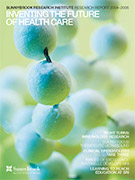Raising the Volume on a Silent Killer
Hypertension (high blood pressure) is the second-leading cause of end-stage kidney disease (ESKD), a life-threatening condition requiring dialysis or transplantation; the first is diabetes. Diabetes is a risk factor for hypertension, and vice-versa. Together, they dramatically increase risk for ESKD. And for every person with ESKD from diabetes, 20 have already died from heart attack or stroke. Controlling hypertension in people with diabetes, therefore, is crucial. Here's where it gets complicated.
Doctors know how to treat hypertension. "It's not rocket science," says Sheldon Tobe, an associate scientist at Sunnybrook Research Institute. "We have the knowledge, technology and drugs. The issue is implementation."
As a nephrologist treating patients with kidney failure, Tobe butted up against that reality for years. As a researcher, he found the solution in the DREAM 3 study (Diabetes Risk Evaluation and Microalbuminuria). In this study, he tested the effectiveness of a community-based strategy, in which home care nurses implemented a treatment program of antihypertensive medication in First Nations people with diabetes.
The results: participants receiving treatment saw a 24-point reduction in systolic blood pressure (BP) (the top number in a BP reading, taken as the heart contracts) and an 11.6-point reduction in diastolic BP (the bottom number, measured between contractions). The strategy brought BP to the target in 50% of people. The Canadian average for BP control of people with diabetes is 9%. Two years after the completion of the study, their BP was still under control. "We left a lasting impact in that community," says Tobe.
In addition to impacting First Nations communities facing barriers to health services, Tobe found clues to the development of hypertension closer to home. In the 2005 "Double Exposure" study, in which he measured BP in 248 employees at Sunnybrook Health Sciences Centre (SHSC), Tobe determined that marital cohesion was associated with lower systolic BP in subjects experiencing job strain. Later that year, he examined the relationship among drinking alcohol, gender and BP in the same cohort. As expected, he found elevated BP among drinkers; unexpectedly, females had higher BP than did males, especially during times spouses spent together. "Across the board, women tend to have lower BP than men, so it was a striking finding," says Tobe.
Also surprisingly, the study revealed that 22% of 352 additional SHSC employees screened as potential participants had hypertension, and 40% of those didn't know it—just like the general population. It's a reminder that education and easy access to health care don't always bring implementation and treatment. Two people's readings were so high that they would have had a stroke within weeks. Tobe says, "Our bottom line for people who may be at risk is they should have their blood pressure checked." And that's a wake-up call for us all.
The Canadian Institutes of Health Research in partnership with Pfizer Inc. and the Heart and Stroke Foundation of Ontario funded Tobe's studies.
PDF / View full media release »





